Electronic Warfare and Radar Systems Engineering Handbook |
|
IFF - IDENTIFICATION - FRIEND OR FOE Originated in WWII for just that purpose - a way for our secondary radars to identify U.S. aircraft from enemy aircraft by assigning a unique identifier code to U.S. aircraft transponders. The system is considered a secondary radar system since it operates completely differently and independently of the primary radar system that tracks aircraft skin returns only, although the same CRT display is frequently used for both. The system was initially intended to distinguish between enemy and friend but has evolved such that the term "IFF" commonly refers to all modes of operation, including civil and foreign aircraft use. There are four major modes of operation currently in use by military aircraft plus one submode.
A cross-band beacon is used, which simply means that the interrogation pulses are at one frequency and the reply pulses are at a different frequency. 1030 MHz and 1090 MHz is a popular frequency pair used in the U.S. The secondary radar transmits a series of selectable coded pulses. The aircraft transponder receives and decodes the interrogation pulses. If the interrogation code is correct, the aircraft transponder transmits a different series of coded pulses as a reply.
The advantage of the transponder is that the coded pulses "squawked" by the aircraft transponders after being interrogated might typically be transmitted at a 10 watt ERP, which is much stronger than the microwatt skin return to the primary radar. Input power levels may be on the order of several hundred watts. The transponder antenna is low gain so that it can receive and reply to a radar from any direction. An adjunct to the IFF beacon is the altitude encoding transponder known as mode C - all commercial and military aircraft have them, but a fair percentage of general aviation light aircraft do not because of cost. The number of transponder installations rises around many large metropolitan areas where they are required for safety (easier identification of aircraft radar tracks).
Air traffic control primary radars are similar to the two dimensional search radar (working in azimuth and range only) and cannot measure altitude. The expanded display in figure 1 is typical of an air traffic control IFF response. The aircraft was told to squawk a four digit number such as "4732". The altitude encoded transponder provides the aircraft altitude readout to the ground controllers display along with the coded response identifying that particular aircraft.
 Figure 1. IFF Transponder Note: The radar I worked on in the USAF sported a TPX-42 IFF systems. Some of its components, including the "Tootsie Roll" antenna on top of the shelter and the equipment rack inside, can be seen in the pictures on my 5CCG radar shop page.
Table of Contents for Electronics Warfare and Radar Engineering Handbook Introduction | Abbreviations | Decibel | Duty Cycle | Doppler Shift | Radar Horizon / Line of Sight | Propagation Time / Resolution | Modulation | Transforms / Wavelets | Antenna Introduction / Basics | Polarization | Radiation Patterns | Frequency / Phase Effects of Antennas | Antenna Near Field | Radiation Hazards | Power Density | One-Way Radar Equation / RF Propagation | Two-Way Radar Equation (Monostatic) | Alternate Two-Way Radar Equation | Two-Way Radar Equation (Bistatic) | Jamming to Signal (J/S) Ratio - Constant Power [Saturated] Jamming | Support Jamming | Radar Cross Section (RCS) | Emission Control (EMCON) | RF Atmospheric Absorption / Ducting | Receiver Sensitivity / Noise | Receiver Types and Characteristics | General Radar Display Types | IFF - Identification - Friend or Foe | Receiver Tests | Signal Sorting Methods and Direction Finding | Voltage Standing Wave Ratio (VSWR) / Reflection Coefficient / Return Loss / Mismatch Loss | Microwave Coaxial Connectors | Power Dividers/Combiner and Directional Couplers | Attenuators / Filters / DC Blocks | Terminations / Dummy Loads | Circulators and Diplexers | Mixers and Frequency Discriminators | Detectors | Microwave Measurements | Microwave Waveguides and Coaxial Cable | Electro-Optics | Laser Safety | Mach Number and Airspeed vs. Altitude Mach Number | EMP/ Aircraft Dimensions | Data Busses | RS-232 Interface | RS-422 Balanced Voltage Interface | RS-485 Interface | IEEE-488 Interface Bus (HP-IB/GP-IB) | MIL-STD-1553 & 1773 Data Bus | This HTML version may be printed but not reproduced on websites.
Related Pages on RF Cafe - Introduction to Radar (Air University) - Radar Equation, 2-Way (another) - Radar Techniques - Primer (1945 QST) - RF Cafe Quiz #7 - Radar Principles - EW/Radar Handbook - Doppler Shift - Identification Friend or Foe (IFF) |